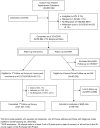Characteristics and utilisation of the Mayo Clinic Biobank, a clinic-based prospective collection in the USA: cohort profile
- PMID: 31699749
- PMCID: PMC6858142
- DOI: 10.1136/bmjopen-2019-032707
Characteristics and utilisation of the Mayo Clinic Biobank, a clinic-based prospective collection in the USA: cohort profile
Abstract
Purpose: The Mayo Clinic Biobank was established to provide a large group of patients from which comparison groups (ie, controls) could be selected for case-control studies, to create a prospective cohort with sufficient power for common outcomes and to support electronic health record (EHR) studies.
Participants: A total of 56 862 participants enrolled (21% response rate) into the Mayo Clinic Biobank from Rochester, Minnesota (77%, n=43 836), Jacksonville, Florida (18%, n=10 368) and La Crosse, Wisconsin (5%, n=2658). Participants were all Mayo Clinic patients, 18 years of age or older and US residents.
Findings to date: Overall, 43% of participants were 65 years of age or older and female participants were more frequent (59%) than males at all sites. Most participants resided in the Upper Midwest regions of the USA (Minnesota, Iowa, Illinois or Wisconsin), Florida or Georgia. Self-reported race among Biobank participants was 90% white. Here we provide examples of the types of studies that have successfully utilised the resource, including (1) investigations of the population itself, (2) provision of controls for case-control studies, (3) genotype-driven research, (4) EHR-based research and (5) prospective recruitment to other studies. Over 270 projects have been approved to date to access Biobank data and/or samples; over 200 000 sample aliquots have been approved for distribution.
Future plans: The data and samples in the Mayo Clinic Biobank can be used for various types of epidemiological and clinical studies, especially in the setting of case-control studies for which the Biobank samples serve as control samples. We are planning cohort studies with additional follow-up and acquisition of genetic information on a large scale.
Keywords: cohort; electronic health records; mayo clinic biobank.
© Author(s) (or their employer(s)) 2019. Re-use permitted under CC BY-NC. No commercial re-use. See rights and permissions. Published by BMJ.
Conflict of interest statement
Competing interests: None declared.
Figures




References
-
- Centers for Disease Control and Prevention Behavioral risk factor surveillance system. Available: https://www.cdc.gov/brfss/index.html [Accessed 9 Jan 2019].
Publication types
MeSH terms
Grants and funding
LinkOut - more resources
Full Text Sources
